- Home
- Deborah Harkness
The World of All Souls Page 32
The World of All Souls Read online
Page 32
The third eye is another ancient concept in myth and religion worldwide, associated with visions or clairvoyance. People who claim to use their third eye are often perceived as seers, and many witches in the All Souls world are gifted with second sight, as was Diana’s mother, Rebecca. In modern Wicca a person’s third eye is an important energy point and linked to the color indigo (Diana’s third eye is described as blue). It is related to a person’s intuitive gifts, as well as openness, empathy, and self-awareness. Scientists, too, have speculated about the evolution of the pineal gland (still active in some animals) in the human brain. Often known as nature’s first eye, it has always been connected with ancient myths of the third eye. There is still much that is unknown about the pineal gland’s influence and power over human reactions and intuition.
Scrying
Elizabeth Jackson, the waterwitch in sixteenth-century London, was a gifted seer who was brought in to train Diana in the art of scrying. Scrying is a method of divination using a reflective or shiny device. It is an art used by witches gifted with second sight in the All Souls world, as well as by certain unruly daemons such as Edward Kelley. Various techniques and apparatus can be used. For example, the waterwitches of London used scrying bowls filled with water to divine the fact that the weaver coming to them would have water in her veins. Emily Mather used a scrying stone to summon spirits of the dead, which is what she was attempting when she confronted Peter Knox and Gerbert d’Aurillac.
Scrying has roots going far back across ancient cultures in history. Translucent, reflective, or luminescent substances were commonly used, including water, stones, crystals, and mirrors. The resulting visions were often believed to be from the subconscious or from conjured spirits, dark and light. One of the most famous scryers in history was, of course, John Dee’s assistant Edward Kelley. Dee’s aim was nothing less than to uncover the mysteries of the natural world and its apocalyptic end. When his experiments and extensive collection of books did not provide that knowledge, he employed scryers as a conduit to the celestial angels who would unlock the secrets he craved. Dee carefully documented their long, grueling scrying sessions. In their “conversations with angels,” Dee sought guidance on a vast range of subjects, from mathematics to astrology. Wherever Kelley’s inspiration and visions came from, Dee seems to have believed enthusiastically in his talents—even when Kelley received the infamous message that they were to share everything, even their wives. This marked the beginning of the end of the Dees’ and Kelleys’ relationship, however.
The reflective objects Dee used in the angel conversations were called showstones. These were a “great Chrystaline Globe,” a “stone in the frame,” and a stone Dee believed had been left by angels in his oratory window in Mortlake. This third stone, which Dee set in gold and intended to wear around his neck, he thought to be the most powerful, and only Dee was allowed to touch it. A fourth stone, a black obsidian mirror that is currently in the British Museum, is also associated with Dee’s angel conversations. But there is no concrete evidence from his diaries that this was used (he made sketches of his showstones, and it is not among them) or in fact that it was ever owned by him.
Brazen Head
The brazen head (or brass head) was a prophetic device reportedly used by medieval and Renaissance wizard scholars. The vampire Gerbert d’Aurillac possessed this legendary tool during his time as Pope Sylvester II. Tales of this head feature in the chronicles of a key historical source of the early twelfth century, William of Malmesbury. Malmesbury describes how the devilishly knowledgeable pope built a talking head that would answer yes or no to questions put to it. Another medieval scholar and monk, Roger Bacon, is famously said to have spent years constructing such a device with his assistant Friar Bungy, although it ultimately proved unsuccessful.
Andrew Hubbard revealed to Diana that it was in fact Matthew’s manipulative son Benjamin who gave Gerbert’s oracle-speaking brass head to Roger Bacon. Benjamin hoped to exchange the oracle for the Book of Life, which Bacon possessed at the time. But Bacon took the head without relinquishing the book, something for which Benjamin always cursed him. The present whereabouts of Gerbert’s brazen head are unknown.
The Craft
White Magic and Higher, Dark Magic
“But Em always said higher magics were too dark for witches to handle safely. . . . She said any witch who thought she was immune to their dangers would find out the hard way just how powerful they were.”
The idea of witchcraft as evil is inextricably bound up with Christian attitudes toward knowledge and power. When the Renaissance reached northern Europe in the sixteenth century, it brought renewed enthusiasm for the intellectual achievements of the ancient Romans and Greeks. The technology of the printing press made their knowledge more accessible than ever before. But the established church saw the growing wave of learning and independent thought as the devil’s work. Printing was actually described as the black art. As ordinary educated people tried to understand the workings of the natural world by pursuing natural magic (what we would consider early science), the church saw this as trespassing on its own sacred vocation of explaining the miracles of God’s creation. All magic, therefore, was seen as evil—the work of the devil.
Mathematics, too, often fell into the category of magic. Some saw it as the language of God, who, according to some biblical passages, created everything on earth abiding by principles of number, weight, and measure. How could such a tool be trusted in the hands of common folk? Others believed the calculations used in astrology and other forms of divination were magic. John Dee used mathematics to cast horoscopes, practice numerology and alchemy, and facilitate his famous conversations with angels. The line between science and magic was thin.
When traditions of medieval and early modern witchcraft were revived in the mid-twentieth century under the rubric of Wicca, magic was no longer viewed as bad in itself. Good magic, or white magic, was distinguished by the practitioner’s intent to do good for others as opposed to benefiting him- or herself. Bad magic, or black magic, was selfish in nature and aimed at obtaining power over others.
In the All Souls world, the terms “white magic” and “black magic” are not used at all. Most witches practice magic in the form of helpful spells, as Sarah Bishop does, to find lost dogs and banish nightmares. A few, such as Diana’s mother, Rebecca, experiment in the more powerful darker or higher magics that can summon spirits and cross the boundary between the living and the dead. But darker magic is not necessarily evil—it is simply more powerful than everyday magic and needs to be used responsibly. Any magic can be evil if it’s in the wrong hands.
Diana Bishop spent most of her life fleeing from her magical birthright. She believed her parents had died because of their involvement with magic and their identities as witches. Her solution was to stay as far away from magic as she could. But her Aunt Sarah reproved Diana when she suggested that the higher, darker magics were inherently evil. “Think about worldly power. In beneficent hands it’s a force for good. But if someone abuses it for personal gain or to harm others, it can be terribly destructive. The darkness depends on the witch.” She also reminded Diana that dark doesn’t necessarily mean evil. What it mainly represents is knowledge. “There is nothing more powerful than knowledge. That’s why we’re so careful when we teach someone dark magic,” said Sarah.
Diana’s acceptance of herself depended on embracing her tremendous innate power. Her visit to the sixteenth century, where magical knowledge and scientific knowledge existed side by side, was crucial in teaching her how to use even dark power for good. It is no coincidence that one of the three items she required to timewalk back to Elizabethan London was the manuscript of Christopher Marlowe’s play The Tragical History of the Life and Death of Doctor Faustus. The legend of Faust encapsulated Diana’s dilemma as well as the central dilemma of the sixteenth century: What price must be paid for too much knowledge? Faustus had mastered the kno
wledge available in books and found it insufficient—he wanted the occult knowledge that only magic could provide. He sold his soul to the devil in exchange for twenty-four years of power and (in a parallel with Diana’s parents’ fate) paid the price of being torn to pieces by devils at the end of it.
Diana learned to create her own spells using weaving cords, which later became a part of her body. Initially she balked at exercising the powers of life and death and was unable to kill Benjamin when he seized Phoebe at the Bodleian Library. In Chelm, however, there was no hesitation: Diana deployed her full power and sent the goddess’s magical arrow into Benjamin’s heart.
Grimoires (The Bishop Grimoire)
A grimoire is basically a cookbook of magic, explaining how to create magical objects, perform spells, and even summon spirits. In some cases the grimoire itself was supposed to possess some magical power; this was especially true of handwritten grimoires. Ashmole 782, also known as the Book of Life, was an example of a book that held inherent power. The wizard Peter Knox lusted after Ashmole 782 because he believed it was the very first grimoire, the true source of all the witches’ power over the centuries. He was convinced that the book contained the secret of immortality and how to destroy vampires, which fit neatly into his plan for world domination by witches. In a way Knox was right; the Book of Life did contain the secret of immortality, or at least the continued existence of all creatures.
The use of grimoires goes back to the Mesopotamians and early Egyptians, who inscribed magical incantations on clay tablets or amulets. Some early Christian sects also used grimoires. As Christianity grew more mainstream, the church suppressed books on magic because their link to paganism was a threat to established Christian doctrine. But because religious texts are often perceived to have their own innate power, it was difficult for the church to make a clear distinction between religious devotion and magic.
The term “grimoire” most likely derives from the French word grammaire, which originally referred to a book written in Latin. According to the historian Owen Davies, this is because a book written in Latin would be difficult for most people to read; to say “It is like a grimoire to me” was akin to our modern saying “It’s all Greek to me!” By the eighteenth century, the word was widely used in France to mean a magic book, and in the nineteenth century it began occurring in regular English usage.* In the All Souls trilogy, the term describing how a weaver puts his or her magic into words is “gramarye,” which also derives from “grammaire.”
In the All Souls world, a grimoire is usually a detailed record of every witch family and the spells its members practiced over the centuries. The Bishop grimoire is more than three hundred years old and contains the Bishop family tree back to Rebecca Davies, the grandmother of the famous Bridget Bishop who was executed in Salem, Massachusetts. It also records all the spells that the Bishop family witches practiced over the years, along with annotations regarding each witch’s success—making it much like a family cookbook. As a devoted student of the traditions of witchcraft, Sarah prizes the Bishop grimoire above all things. The only time she allowed it out of the house was on Diana’s thirteenth birthday, when Diana was presented to the coven in a coming-of-age ritual for witches. The young witch was supposed to perform three ceremonial magic spells: lighting a candle, opening a book, and causing a bell to ring. Diana failed miserably, because her elemental powers were spellbound and, because she is a weaver, her talents could not be used to repeat the spells of others but only to create spells of her own.
As a weaver, Diana has little use for grimoires kept by other witches, because she sees spells not in words but in shapes and colors. She can pull on the threads of the world to weave spells that are not in any book. Most witches, however, can only perform the spells of others, which is why so many spells are outdated. As weavers grew scarcer because of persecution by their own kind, the production of new spells ceased. Once the Madison coven learned that Diana could create new spells, they were overjoyed (one witch was particularly keen for a spell that could unfreeze a computer).
The only spells that were not kept in the family grimoire were those that used the higher, darker magics. Witches skilled in the use of these spells kept their own separate grimoire, presumably because the magic was potentially dangerous in the wrong hands.
Herbal
“Herbal magic, the power to affect growing things—the basics. Combined with spell casting, cursing, and charms—or any one of them, really—it means you have not only powerful magical abilities but an innate talent for witchcraft.”
Like the use of grimoires, the practice of herbal magic dates back to ancient civilizations. In Egypt, for example, the healing arts depended on a variety of disciplines that combined knowledge of herbs with alchemy, astrology, and astronomy. Along with amulets and spoken incantations, herbs were used to protect the home from ghosts and spirits.
Well into the Middle Ages, cunning women continued to use traditional methods of herbal healing throughout Europe. Their cures combined magic stones and charms, religious incantations and herbs, some of which were undoubtedly of no use at all, others of which are still used today. Medieval wives in large households kept their own stock of herbs to concoct remedies. As we know, Marthe stored hers in a special stillroom at Sept-Tours, including her recipe for contraceptive tea. Monasteries kept herb gardens, and monks experimented with the herbs described in classical texts, some even writing their own books about herbal remedies. Herbs were one of the few effective tools that medieval physicians and cunning women had, and their study was widely respected.
By the fourteenth century, however, as fear of witchcraft grew, the use of herbs was potentially more suspect. Collecting herbs in a way that smacked of ritual—for example, on certain dates or phases of the moon—could give rise to a charge of witchcraft. Sometimes simply having knowledge of herbs was enough to raise a neighbor’s suspicion. But in general, practicing herbalists did not tend to be accused of witchcraft unless there were other crimes (or grudges) to lay at their doorstep. If there was a suspected poisoning in the area, for example, the herbalist was often the first to be questioned, as knowledge of herbs obviously required knowledge of their poisonous properties as well. There was a long tradition of conflating the herbalist or witch with a poisoner, the mythological witch Circe being a major example. In one story the sea god Glaucus spurned Circe in favor of the nymph Scylla, and Circe revenged herself by poisoning the water where Scylla bathed, turning her into a monster.
The degree of herbal magic used by witches in the All Souls world depends on their individual powers and personal inclinations. In sixteenth-century London, the witch Marjorie Cooper used agrimony to break enchantments, feverfew for protection, rosemary for purification and clarity. Susanna Norman used boneset for protection and groundsel for good health. In the twenty-first century, Sarah Bishop studies the properties of herbs and their uses and has instructed the Madison coven’s children on the elemental associations of flowers, plants, and herbs. She has an entire room dedicated to the drying and storage of magical and medicinal herbs, and has done her best to instruct Diana in their uses as well.
When Sarah and Diana created magical charms, the herbs they used were the herbs of modern Wicca. Diana’s recipe for children’s dream pillows consisted of moonwort pods, agrimony, aniseed, hops, valerian, bay leaf, rosemary, and thyme. Wiccan sites recommend combining moonwort and agrimony when making dream pillows; moonwort is especially recommended for protection from monsters, and agrimony helps overcome fear. Aniseed is said to ward off the evil eye, and bay leaf also is advised for its protective properties. Wiccans place bay leaf in each corner of a room to protect the inhabitants.
In the sixteenth century, Diana was proud to have learned the names and scents of all the herbs in Marthe’s contraceptive tea, then ashamed to realize how little else she knew about them compared with other sixteenth-century women. After exploring her powers as a weaver with t
he London coven, however, she placed less importance on herbal knowledge. Though she practiced herbal magic with Sarah at the Madison house, Diana became more dismissive of Sarah’s seemingly bottomless knowledge. “Her mastery was born of reading and study. I had learned the limits of book-based knowledge in Mary Sidney’s alchemical laboratory, when I was confronted for the first time with the challenges of doing what I’d spent years reading and writing about as a scholar.”
Spellbinding
In most dictionaries, “spellbound” means “held by a spell” or having your attention held by magic power. This suggests a pleasant experience, but in the All Souls world, being spellbound is anything but enjoyable. For a witch, being spellbound means to be robbed of all her magical powers, leaving her at risk as a nonhuman creature but without any special abilities to protect herself. Spellbinding casts the witch out defenseless into a dangerous world. In early modern Europe, humans believed that being spellbound by a witch could cause a person’s animals to die, his crops to fail, or, as the Malleus Maleficarum pointed out, his penis to disappear (or, just as bad, to appear to have disappeared).

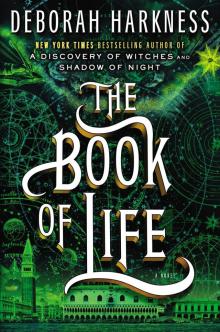 The Book of Life
The Book of Life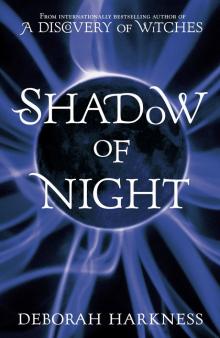 Shadow of Night
Shadow of Night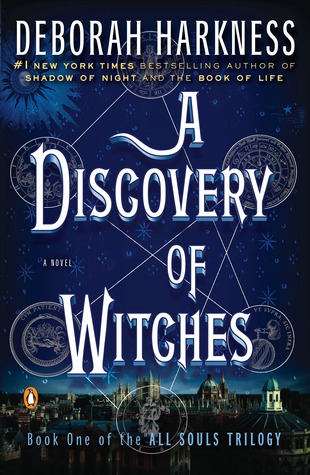 A Discovery of Witches
A Discovery of Witches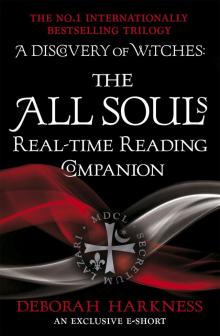 The All Souls Real-Time Reading Companion
The All Souls Real-Time Reading Companion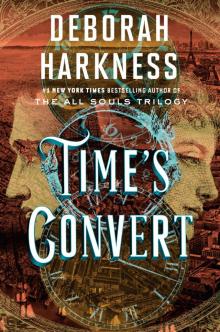 Time's Convert
Time's Convert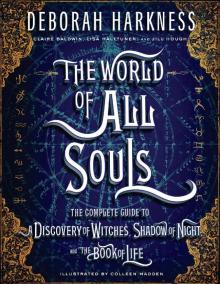 The World of All Souls
The World of All Souls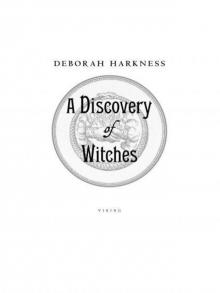 A Discovery of Witches: A Novel (All Souls Trilogy)
A Discovery of Witches: A Novel (All Souls Trilogy) Shadow of Night: A Novel
Shadow of Night: A Novel